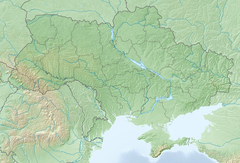 | |
| Alternative names | UTR-2 |
|---|---|
| Part of | Giant Ukrainian Radio Telescope URAN |
| Location(s) | Volokhiv Yar, Chuhuiv Raion, Kharkiv Oblast, Ukraine |
| Coordinates | 49°38′17″N 36°56′10″E / 49.6381°N 36.9361°E / 49.6381; 36.9361 |
| Organization | Institute of Radio Astronomy of the National Academy of Sciences of Ukraine |
| Wavelength | 9.1 m (33 MHz)–37 m (8.1 MHz) |
| Built | 1970–1972 (1970–1972) |
| First light | 1972 |
| Telescope style | phased array radio telescope |
| Angular resolution | 40 arcminute |
| Collecting area | 15 ha (1,600,000 sq ft) |
 | |
| [REDACTED] Related media on Commons | |
| [edit on Wikidata] | |
The Ukrainian T-shaped Radio telescope, second modification (official abbreviation UTR-2) is the world's largest low-frequency radio telescope at decametre wavelengths. It was completed in 1972 near the village of Hrakovo (49°38′N 36°56′E / 49.633°N 36.933°E / 49.633; 36.933), 15 km west-south-west from Shevchenkove, Ukraine. The telescope is operated by the Institute of Radio Astronomy of the Ukrainian Academy of Sciences.



The UTR-2 consists of an array of 2040 dipole elements in two arms each containing 6 rows of elements, oriented in a T shape: a north–south arm consisting of 1440 elements covering an area of 1800×60 meters, and an east–west arm consisting of 600 elements covering an area of 900×60 meters. The basic element is a broadband cage dipole 1.8 m in diameter and 8 m long made of galvanized steel wire, mounted 3.5 m above the ground, with a balun to connect it to the transmission line. The dipoles are all oriented along the east–west axis, with the spacing between rows of 7.5 m in east–west direction and 9 m in north–south. It has a total area of 150,000 square metres (1,600,000 sq ft), and a resolution of about 40 arcminutes at the middle frequency 16.7 MHz. The operating frequency range is 8–33 MHz. The sensitivity is about 10 mJy.
Steering of the antenna main lobe is accomplished with phase shifters consisting of switchable delay lines.
The telescope is a part of the URAN (Ukrainian Radio Interferometer of NASU) decametric VLBI system, which includes another four significantly smaller low-frequency radio telescopes. That system has bases from 40 to 900 km (25 to 562 mi).
The telescope was seriously damaged during 2022 Russian invasion of Ukraine, the observatory's measuring complex and scientific equipment (but not the antennas) were completely destroyed.
The UTR-2 and GURT observatories repair will cost an estimated $4 million US (of which $150,000 has been secured from Ukraine's National Academy of Sciences (NAS)). This reflects the critical reliance on foreign funds and international collaboration for both scientific endeavors and education. Despite these challenges, foreign scientists remain optimistic about the observatory’s future.
See also
References
- "Під час окупації Волохового Яру на Харківщині було пошкоджено найбільший у світі радіотелескоп декаметрових хвиль УТР-2". Інтерфакс-Україна (in Ukrainian). Retrieved 2022-10-28.
- Stone, Richard (2022-12-07). "Hero City". Science. American Association for the Advancement of Science. Retrieved 2022-12-10.
- Lusito, Eric (2024-06-14). "A SHATTERED WINDOW TO THE RADIO SKY". Science. American Association for the Advancement of Science. Retrieved 2024-07-02.
External links
- Institute of Radio Astronomy of the National Academy of Sciences of Ukraine
- Braude, S. Ia.; Megn, A. V.; Riabov, B. P.; Sharykin, N. K.; Zhuk, I. N., Decametric survey of discrete sources in the Northern sky. I - The UTR-2 radio telescope: Experimental techniques and data processing, Astrophys. and Space Sci., 54, 3–36, 1978
- URAN-3 radio interferometer antenna field (abandoned)
- A. Konovalenko, L. Sodin, V. Zakharenko, P. Zarka, O. Ulyanov, M. Sidorchuk, S. Stepkin, P. Tokarsky et al. The modern radio astronomy network in Ukraine: UTR-2, URAN and GURT, Experimental Astronomy, Vol. 42, Is. 1, pp 11–48.